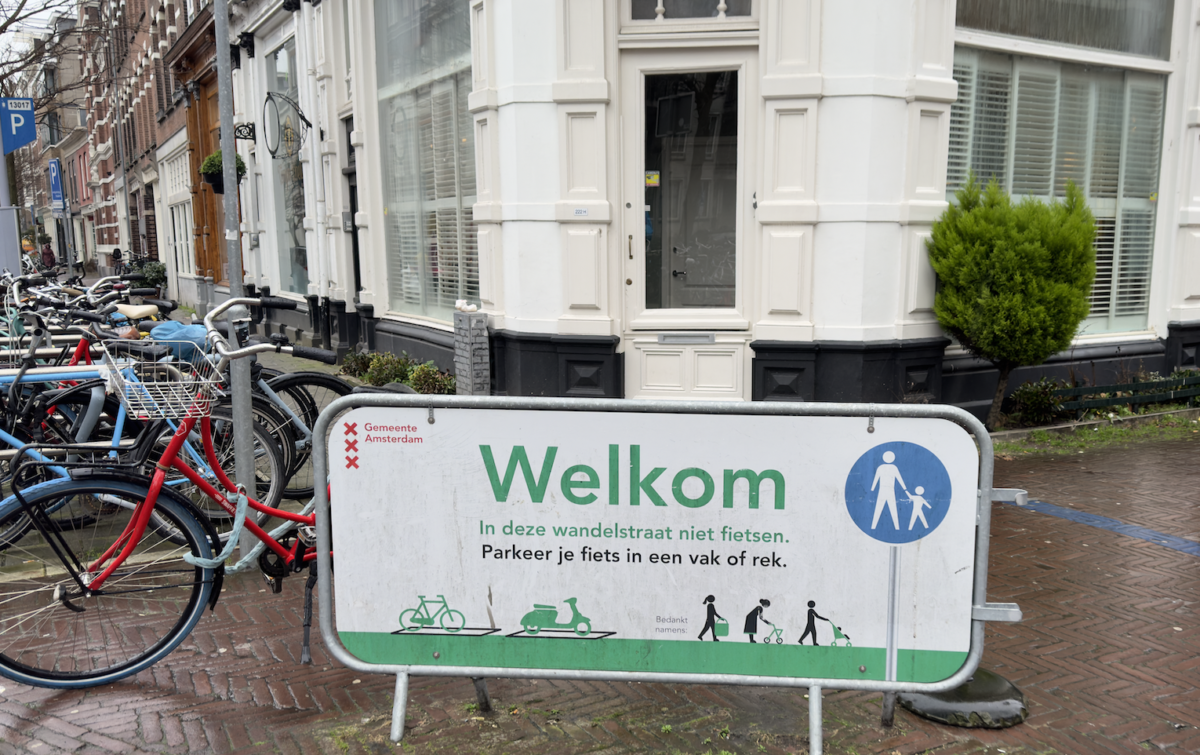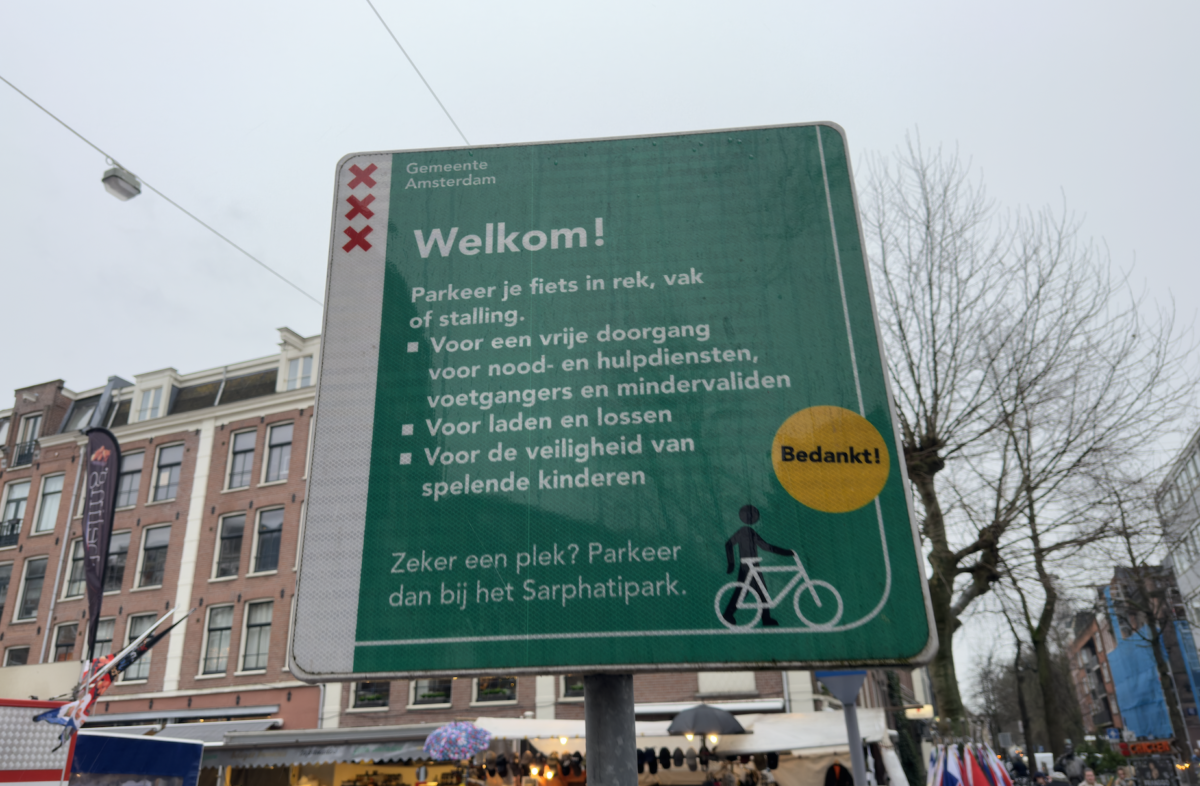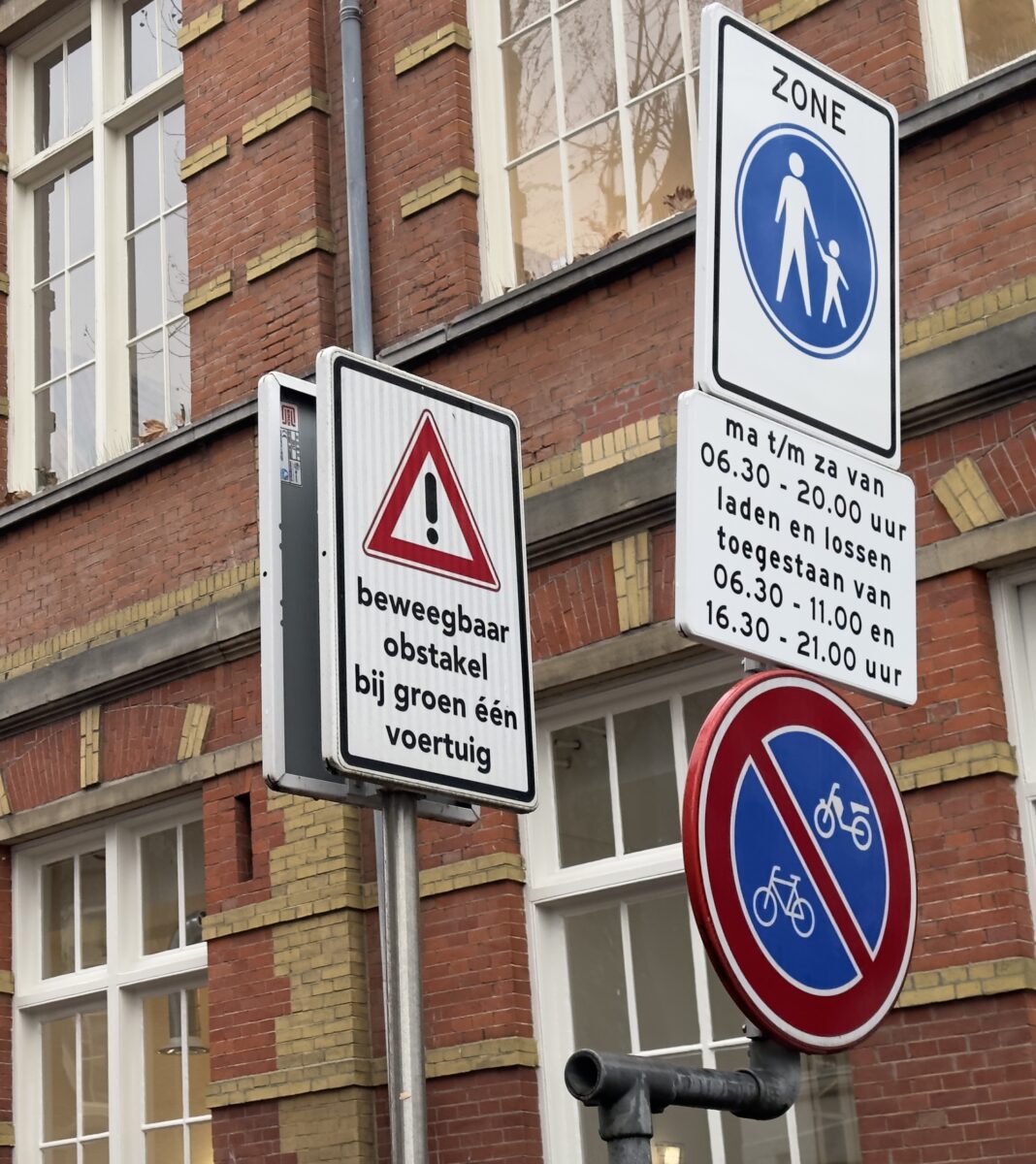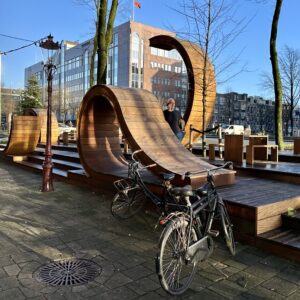
Info Box
- Fact
- Fact 2
- Fact 3
— This post is part of BikePortland Staff Writer Taylor Griggs’ trip through Europe. See previous dispatches here.
They told me they were fining me for riding my bike illegally.
People who visit Amsterdam often discuss the dangers people face while attempting to walk on the bike-filled streets. I think this is a bit exaggerated, especially by Americans who are unfazed by masses of cars and not used to seeing so many people biking at once, so I’ll usually play devil’s advocate to that claim and say something about the comparative danger of getting hit by someone riding a bike versus someone driving a car. I also don’t necessarily fault Dutch bicyclists for being a little annoyed when a tourist — especially one who just spent a couple hours smoking in a coffee shop — walks right through their path.
I walked a lot while I was there, and did have a couple of close calls with people on bikes even though I was paying very close attention to the traffic flow (and was fully lucid!). My opinion is generally that whoever is using the larger and more powerful vehicle bears the majority of the responsibility for making sure more vulnerable road users are safe. In these situations, though, I think I probably earned the insults I received when someone on a bike had to swerve to avoid me. (This only happened once, and they spoke Dutch, so I remain blissfully ignorant to what was said.)
However, there’s an art to walking in Amsterdam, and I think the city could probably stand to make it a little more clear to visitors using all modes of transportation how to abide by it. They have made an effort to create spaces where pedestrians have full reign — in most of the public plazas I wrote about earlier, people on bikes are required to dismount and walk — but the signs marking these spaces are 1) not always very conspicuous and 2) in Dutch. And I learned the risks of not heeding these signs the hard way.


How I almost went to jail
The police were skeptical when I told them I didn’t know this was a pedestrian-only area.
Like I said, I did a lot of walking in Amsterdam, but of course I rode a bike as well — and my experience wasn’t without snags. About two minutes after I picked up my rental bike from a shop in Rembrandtplein, a touristy area in the city center, I was apprehended by two police officers who saw me trying to bike through what was evidently a pedestrian-only area. (I say tried, because I was having a hard time with the coaster brake on my bike and almost fell on a tram track.) Since I picked up my bike from a shop in the middle of this street, I missed the sign at the entrance that signaled these rules.
They yelled something in Dutch, and at first I didn’t know who they were talking to or what they were saying, but they caught up to me and told me to step aside and hand over my passport. I asked why, and after some back and forth, they told me they were fining me for riding my bike illegally.
I was a little agitated, but I tried to keep calm. They took down my information, including the address of my hostel, saying if I didn’t give it to them they’d have to take me to jail. Now, I figured this was an exaggeration, but also knew that if I was really sent to Dutch jail for riding a bike in a pedestrian zone at least I wouldn’t have to worry about getting fired from my job at BikePortland. Still, it would be kind of annoying, so I tried to avoid it.
For some reason, the police were skeptical when I told them I didn’t know this was a pedestrian-only area: it seemed like they thought I was purposely trying to hurt people walking in the street. In Portland, I pride myself on being able to navigate conflict with people walking, even when I occasionally have to ride on the sidewalks, so I didn’t like the accusation that I am inconsiderate of pedestrians!
I kept stressing my ignorance and it seemed like they believed me in the end. At least, they didn’t give me a fine — though, come to think of it, maybe I’ll receive a bill from my hostel in a couple weeks.
I was surprised by how seriously the police took my affront, and even a little impressed they took pedestrian safety so seriously. For the rest of the day, I biked very timidly, dismounting whenever I didn’t see another person on a bike going my same direction, or a clear sign that it was okay for me to be in the area. I don’t think this behavior made pedestrians any safer, but it did make it more difficult for me to get around.
I don’t have a problem with areas only for pedestrians, especially in a place like Amsterdam where there are so many cyclists, but there must be a better way to manage the biker/walker relationship beyond jail threats and fines. Here’s my thought: the fewer cars on the streets, the more room there would be for people using all modes of active transportation to coexist. They’re doing a pretty good job of this in Amsterdam, but it could be better.
Finally, I will admit that my English-speaking arrogance is partly to blame: I should’ve learned more Dutch before traveling to The Netherlands. That wouldn’t have hurt, either.






Thanks for reading.
BikePortland has served this community with independent community journalism since 2005. We rely on subscriptions from readers like you to survive. Your financial support is vital in keeping this valuable resource alive and well.
Please subscribe today to strengthen and expand our work.
Thanks for this informative story, Taylor. I appreciate you taking time to also explore Amsterdam on foot. It’s good to know that you didn’t spend the night in jail and that you’re considerate of pedestrians in Portland (although I never doubted this). I’m looking forward to seeing more of your photos.
Welcome to total law enforcement.
When you live in Portland, do you not cross the street downtown when the signal says “don’t walk”? Or do you ignore it? Do you bike through crowds at Saturday Market and at block party events, in spite of the signs asking you to dismount? When riding on narrow sidewalks, bridges, and pathways, do you actually yield to pedestrians by dismounting?
I’ve known many foreign friends who faked an ignorance of English to get out of speeding tickets in the US – it often works too.
I find it interesting that in this site there are some who comment and feel that if they are on their bikes they pose no threat to a pedestrian and should be able to ignore rules and laws. It is interesting that the police (as an extension of politicians and their voters) in Amsterdam see bikes as a serious danger to pedestrians and enforce applicable rules that look out for the safety of people walking.
Sure wish pedestrians in this city/country would be looked out with similar rules and enforcement. If that’d happen I might actually get out and walk like I used to before the rules of the road became ignored by all too many.
Are you assuming everyone in Portland doe all those things David?,
Really enjoying these dispatches!
I too spent the vast majority of my time in Amsterdam as a pedestrian rather than a cyclist. And I too came away really impressed with how well designed the entire transit ecosystem was in general. I remember my biggest gripe as a pedestrian being trying to cross the more major streets that had bidirectional travel lanes for all 4 modes — ped, bike, car, and tram. So you basically have to get across 8 streams of traffic. It seemed like the timing of the walk signals was never quite enough to get all the way across the street. You’d end up stranded 1/2 or 3/4 of the way into the street, on a pretty cramped pedestrian island between the tram and car lane or the car and bike lane. If there were a lot of pedestrians in any given time of day, these islands could quickly feel very uncomfortable. It seemed to me that this could be avoided by just tweaking the timing/duration of the walk signals, but there’s so much going on on these streets with all the different modes it’s probably not that simple. The fact that this was the most annoying thing I encountered says A LOT tho lol. Generally incredible infrastructure design.
By far the most guilty I was of being the oblivious American tourist was a few days earlier in Hamburg, Germany. There, the most common bike infrastructure treatment seemed to be just repainting/repaving a section of the sidewalk the color red. The red part is the “bike lane”. No other physical separation of space. My partner and I were constantly wandering into the bike lane unconsciously while looking around at the street life and being used to assuming that the whole sidewalk was our space. Thankfully cycling is a somewhat less popular mode there than Amsterdam, but we still had several close calls.
One thing I think people are often surprised by in Europe and the UK is how much heavier the police presence often is. I remember being a tourist in the Netherlands, France, and England and seeing police everywhere, just walking around or patrolling various areas. It seems like their police culture is more like it was decades ago in the US, with more “beat cops” just being present in areas looking out for crimes. In the US, cops are mostly out driving in cars and are rarely out walking the beat.
That was my experience in the UK as well. I also found the officers to be friendly. In 2002, an officer in Carlisle gave me and my mom a ride to the train station when we returned to London.
In Amsterdam you rarely see police in residential areas. You see them in busy areas like everywhere in the world – there’s always police at Times Square in NY as well.
There must be some sort of happy medium between getting threatened with jail for riding a bicycle in a pedestrian area in Amsterdam and the total free for all with no enforcement whatsoever that exists on the streets of Portland, but will we ever find it?
Without context is difficult for you to know but in and around Rembrandtplein is pretty much the only area in the city where they actually fine people on a bike on a consistent basis.
There was a big campaign a few years ago to actually enforce the no bike rules in Rembrandtplein, so basically everyone who lives in the Netherlands knows about it.
So yeah, you got unlucky that a police officer was actually there at the moment, but hence the skeptical attitude. Also: they’re much more likely to stop you if you look like you don’t know what you are doing vs if you’re confidently riding in the wrong place.
I almost got fined once for the same reason in a different place, where they had just installed the new pedestrian only signs and I argued that everyone always bikes there so it would be unfair to give me a fine due to the new sign since I didn’t understand Dutch back then. The police officer was not happy but also did not give me a fine.
Nah – forget about trying to learn to speak the Dutch language. All of the Dutch speak better English than we Americans do, generally speaking.
Thanks for sharing this story. It is 100% true that cyclists do not always yield to pedestrians in Amsterdam, and I actually found that drivers yield to pedestrians more readily than cyclists. That doesn’t mean that there isn’t a lot to be learned from Amsterdam’s cycling culture and infrastructure, but it just goes to show that nowhere is perfect.
Regarding the pedestrian only zones, bikes are often allowed in these areas only during non-business hours. This is because the pedestrianized zones are usually outdoor shopping areas which become crowded during the day and can be dangerous for non-pedestrian traffic. IMO the fines are reasonable as there is a lot of value in providing pedestrian-only spaces, and they need some way to enforce the pedestrian-only policies. There are also shopping areas dominated by bikes (e.g. Harlemmerstraat), so I think the idea is not that all modes have equal access to all urban spaces, but rather that it is generally feasible to move around the city by any mode and there are certain spaces which prioritize one mode over others.
I would add that there are two other kinds of “mode-mixing” that I found uncomfortable in the Netherlands. One is the mixing of bicycles and low-speed mopeds on the bike paths. I didn’t mind the small Canta cars on the paths because they were specifically designed for people with mobility issues and usually weren’t moving at a high speed, but the mopeds were often loud and fast and scared the bejezus out of me everytime they passed. The other problematic mode-mixing was on some paths on the edge of town where pedestrians and cyclists shared the same facility (equivalent to a US multi-use path). When I lived in Eugene, people would always complain about cyclists passing pedestrians too closely and quickly on the river path. Well, that’s nothing compared to the multi-use paths of the Netherlands. There are so many cyclists that it is basically impossible to walk two abreast without causing some kind of conflict, and everyone is used to walking/biking in spaces with cyclists, so the cyclists pass very closely. I’d still say the Netherlands is easily far ahead when it comes to urban mobility, but it is not perfect.
I’m from Amsterdam and lived in Chicago for a couple of years, we took our Dutch city bike to Chicago. I really needed to adjust to the fact that people felt unsafe when I would just pass them as we would do in the Netherlands. Saying “On your left” before you pass a bicyclist is not a thing in the Netherlands, reducing your speed and providing more than 1-2 feet of distance while passing a pedestrian is also not a thing. A method to show that a pedestrian is using too much space on a multi-use path is to zip by with 2 inches to spare. I found out the hard way, that that is not appreciated on the lakefront trail… Also, Chicago pedestrians who would obliviously stray into a bike path without even a glance to see if any traffic is coming (which in the Netherlands is a very big offence, and can get you hurt), would usually curse if startled by us and would blame us for their unsafe feeling.
Of course, we managed to adjust and became way more polite in order not to scare anybody. Having said that, being back in Amsterdam was a big relief from a biking perspective. Now we can rush on the bike again, zip between some other bikers, do some ballsy weaving without having to worry about being cursed at just because someone feels (unrightfully) unsafe. And it is such a blessing to be able to ride long routes, without having to share the road with cars and having to fear being hit at any time.
Ps. We very much enjoyed the Springwater Corridor Trail and loved biking in Portland!
I’m glad you avoided jail, Taylor.
When biking in the Netherlands, most important things to watch for: 1. Police, 2. Trams, 3. Red lights. Otherwise, don’t stop.
Haha as a Dutchy I disagree – 1. Trams (they kill you), 2. Tramrails (they hurt you), 3. Tourist (they don’t see you).
Red lights are optional. I have whizzed by before the Police can react.
Ok, Police that set traps for your bike lights they used to get me – but after growing up a bit I now take care of my bike lights.
(Ps. To all US readers, please don’t use those professional 1000 lumens giga searchlight headlights while biking. Yes you are super visible and you can see everything around you. But the poor sucker that bikes towards you is blinded for a couple of minutes and is at risk of crashing into the next best pothole or ditch. Or at least have the decency to turn them down when someone approaches)
Great stories so far from this trip. Always like to get an external look/comparison of the infrastructure here and in the rest of Europe.
The threat of jail sounds to me (Dutchie) more related to the identification part rather than the cycling. There are, as far as I know in most of Europe, laws that you must be able to present identification to law enforcement upon request. But I’ve not much clue in how much suspicion they need to be allowed to ask.
If you do not present identification then they will indeed take people to the police station to resolve the question who they are, and probably fine them for refusing to give an ID. But that is only knowledge gathered from one of the police vloggers on youtube.
I once almost had my bike impounded in Whistler for a similar situation- they took no-ride zones _very_ seriously. I figured riding at a walking pace was enough. It wasn’t. 🙂
I guess we’re not going to get a privilege check on this happening to a Caucasian woman. The frame here of “taking the law seriously” cannot be taken seriously unless the rest of us, as well as the police, apply it equally.
I don’t want people harassed, much less harmed by the police. Some laws are unjust. But we still have norms.